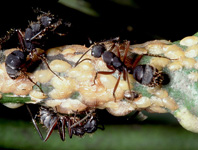Abstract
The beetle cockroach, or genus Diploptera Saussure, has been reviewed recently, with unresolved issues remaining. New materials facilitated a molecular phylogenetic study and further comparisons of male and female genitalia among known species. We performed phylogenetic estimates based on two mitochondrial DNA fragments: 657 bases of COI gene and 376 bases of 16S rRNA gene. We used codon model and doublet model (secondary structure) for COI and 16S respectively, and the predicted secondary structure of sequenced 16S fragment is illustrated. The phylogeny revealed that 1) D. bicolor Hanitsch is a junior synonym of D. maculata Hanitsch, and therefore D. pulchra Anisyutkin is also a new synonym of the latter because of its synonymy with D. bicolor; and 2) D. punctata (Eschscholtz) can be reliably determined only for specimens from Hawaii and continental Asia, and distributional records of this species require re-examination. The male phallic complex and female valvulae are generalized with diagrams, and interspecific differences are discussed. Genital structures of Diploptera are not significantly varied. We notice a superficial linkage between hook-like phallomere and pronotum: a protrusion on the inner margin of hook-apex sclerite is combined with an angular pronotum; whilst no protrusion, no pronotal angles. The differences in valvulae lie with the third valvulae and the anterior arch of second valvifer ring; these may have taxonomic implications. The uniformity in physical property of oothecae suggests that all Diploptera species, not only D. punctata, are viviparous.
References
Anisyutkin, L.N. (2007) A new species of the genus Diploptera Saussure, 1864 from Borneo (Dictyoptera: Blaberidae: Diplopterinae). Zoosystematica Rossica, 16 (2), 173–175.
Buckley, T.R., Simon, C., Flook, P.K. & Misof, B. (2000) Secondary structure and conserved motifs of the frequently sequenced domains IV and V of the insect mitochondrial large subunit rRNA gene. Insect Molecular Biology, 9 (6), 565–580.
https://doi.org/10.1046/j.1365-2583.2000.00220.xCheng, X.-F., Zhang, L.-P., Yu, D.-N., Storey, K.B. & Zhang, J.-Y. (2016) The complete mitochondrial genomes of four cockroaches (Insecta: Blattodea) and phylogenetic analyses within cockroaches. Gene, 586 (1), 115–122.
https://doi.org/10.1016/j.gene.2016.03.057De Rijk, P., Wuyts, J. & De Wachter, R. (2003) RnaViz 2: an improved representation of RNA secondary structure. Bioinformatics, 19 (2), 299–300.
https://doi.org/10.1093/bioinformatics/19.2.299Edgar, R.C. (2004) MUSCLE: multiple sequence alignment with high accuracy and high throughput. Nucleic Acids Research, 32 (5), 1792–1797.
https://doi.org/10.1093/nar/gkh340Fea, L. (1896) Quattro Anni fra i Birmani e le Tribù Limitrofe. Ulrico Hoepli, Milano, 565 pp.
Folmer, O., Black, M., Hoeh, W., Lutz, R. & Vrijenhoek, R. (1994) DNA primers for amplification of mitochondrial cytochrome C oxidase subunit I from diverse metazoan invertebrates. Molecular Marine Biology and Biotechnology, 3 (5), 294–299.
Gillespie, J.J., Johnston, J.S., Cannone, J. & Gutell, R.R. (2006) Characteristics of the nuclear (18S, 5.8S, 28S and 5S) and mitochondrial (12S and 16S) rRNA genes of Apis mellifera (Insecta: Hymenoptera): structure, organization, and retrotransposable elements. Insect Molecular Biology, 15 (5), 657–686.
https://doi.org/10.1111/j.1365-2583.2006.00689.xGuindon, S., Dufayard, J., Lefort, V., Anisimova, M., Hordijk, W. & Gascuel, O. (2010) New algorithms and methods to estimate maximum-likelihood phylogenies: Assessing the performance of PhyML 3.0. Systematic Biology, 59 (3), 307–321.
https://doi.org/10.1093/sysbio/syq010Kambhampati, S. (1995) A phylogeny of cockroaches and related insects based on DNA sequence of mitochondrial ribosomal RNA genes. Proceedings of the National Academy of Sciences of the United States of America, 92 (6), 2017–2020.
https://doi.org/10.1073/pnas.92.6.2017Klass, K.-D. (1997) The external male genitalia and the phylogeny of Blattaria and Mantodea. Bonner Zoologische Monographien, 42, 1–341.
Klass, K.-D. (1998) The ovipositor of Dictyoptera (Insecta): homology and ground-plan of the main elements. Zoologischer Anzeiger, 236 (2–3), 69–101.
Kumar, S., Stecher, G. & Tamura, K. (2016) MEGA7: Molecular Evolutionary Genetics Analysis version 7.0 for bigger datasets. Molecular Biology Evolution, 33 (7), 1870–1874.
https://doi.org/10.1093/molbev/msw054Lenkic, L.E., Wolfe, J.M., Chang, B.S.W. & Tobe, S.S. (2008) Endocrine and reproductive differences and genetic divergence in two populations of the cockroach Diploptera punctata. Journal of Insect Physiology, 54, 931–938.
https://doi.org/10.1016/j.jinsphys.2008.02.009Li, X.R. & Wang, Z.Q. (2015) A taxonomic study of the beetle cockroaches (Diploptera Saussure) from China, with notes on the genus and species worldwide (Blattodea: Blaberidae: Diplopterinae). Zootaxa, 4018 (1), 35–56.
https://doi.org/10.11646/zootaxa.4018.1.2Li, X.-R. & Wang, Z.-Q. (2017) Updating the knowledge of assassin bug cockroaches (Blattodea: Blaberidae: Paranauphoeta Brunner von Wattenwyl): Species from China and taxonomic changes. Entomological Science, 20, 302–317.
https://doi.org/10.1111/ens.12258McKittrick, F.A. (1964) Evolutionary studies of cockroaches. Cornell University Agricultural Experiment Station Memoir, 389, 1–197.
Ronquist, F., Teslenko, M., Der Mark, P.V., Ayres, D.L., Darling, A., Hohna, S., Larget, B., Liu, L., Suchard, M.A. & Huelsenbeck, J.P. (2012) MrBayes 3.2: Efficient Bayesian phylogenetic inference and model choice across a large model space. Systematic Biology, 61 (3), 539–542.
https://doi.org/10.1093/sysbio/sys029Roth, L.M. (1973) The male genitalia of Blattaria. X. Blaberidae. Pycnoscelus, Stilpnoblatta, Proscratea (Pycnoscelinae), and Diploptera (Diplopterinae). Psyche, 80, 249–264.
https://doi.org/10.1155/1973/32467Vršanský, P.V., Šmídová, L., Valaška, D., Barna, P., Vidlička, Ľ., Takáč, P., Pavlik, L., Kúdelová, T., Karim, T.S., Zelagin, D. & Smith, D. (2016) Origin of origami cockroach reveals long-lasting (11 Ma) phenotype instability following viviparity. Science of Nature, 103, 78.
https://doi.org/10.1007/s00114-016-1398-4Zimmerman, E.C. (1948) Insects of Hawaii. Vol. 2. University of Hawaii Press, Honolulu, 475 pp.

